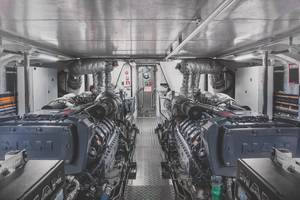-

Alternative Fuels: Many Possibilities But a Clear Path is Evasive
“It was the best of times, it was somewhat confusing times, it was the age of wisdom, it was the age of the learning curve, it was the season of light, it was the season of, uh, still not enough light.” ― Deepest apologies to Charles Dickens, A Tale of Two Cities, 1859As the world zeroes in on alternative energy sources and products that can deliver power and performance, there are advances that could sway even the most hardened skeptic.
-

Making Hydrogen Work: Demo Project in San Francisco Port
Hornblower Energy LLC, in partnership with the Port of San Franciso, the U.S. Department of Energy and six corporate partners, including Air Liquide and Glosten, is leading a project to demonstrate the feasibility and viability of using hydrogen (H2) as a maritime fuel.The project is located at Pier 68 in San Francisco. DOE selected the project for funding in 2020. It’s supposed to be completed in 2025 but there are important decision dates before then.
-

Hydrogen as Fuel: Possibilities, But…
Hydrogen is everywhere. You know that from high school chemistry. And you also know it from Marine News’ almost daily updates about H powered vessel projects around the world.As a fuel that could potentially replace fossil fuels, H is in the spotlight. Perhaps the brightest spotlight, at least in the U.S., is within the Department of Energy’s “Energy Earthshots” initiative.R&D on H was the first such Earthshot announced last year.
-

Batteries: Ready to Scale Up
Batteries for maritime power have been picking up big momentum, benefiting from the most basic concept within Econ 101: supply and demand.On May 19 Corvus Energy announced it would establish a lithium ion battery manufacturing facility in Port Bellingham, Wash., just north of Seattle. Corvus Energy is a leading supplier of battery energy storage systems (BESS) for marine applications. Its systems already power more than 30 North American vessels…
-

Current Direct: A Transition Effort in Europe
The European Union is underwriting a project, called Current Direct, to facilitate and hasten the transition to battery powered commercial maritime vessels. It's funded by the European Union’s Horizon 2020 research and innovation program. It also has 13 private sector partners, including Blackstone Resources, Spear Power Systems and Wärtsilä. It has a quick timeline; a demonstration project should be ready by 2023.New thinking and innovation run across every aspect of this project…
-

Running on Hydrogen – Can it Work?
Hydrogen as fuel was in the spotlight during the last two weeks. The Senate's Energy and Natural Resources Committee held a hearing on February 10 looking at H challenges in the transportation, utility, industrial, commercial, and residential sectors.A week later, the US House Committee on Science, Space, & Technology held a hearing titled "H2Success: Research and Development to Advance a Clean Hydrogen Future."Also…
-

EPA Tier 4: Difficult and Contentious, 12 Years and Counting
When it comes to complying with EPA’s Tier 4 emissions regulations, there’s no shortage of creativity emerging from America’s maritime engineering firms. Companies such as Hug Engineering are offering flexible, customized aftertreatment-based control systems that can assemble almost in modular like fashion. Other companies, such as ABB Group, offer battery-hybrid power sources to complement combustion power and avoid threshold diesel emissions.
-

IMO2020: Low Sulfur Fuel Potential Pitfalls
(This is excerpted from Maritime Reporter & Engineering News' January 2020 "The Path to Zero" column.)Are the world’s ships’ engines ready for IMO compliant very low sulfur fuel? That’s a wide open question as ship owners step to the end of the preparatory gang-plank on January 1, 2020 when 0.5% very low sulfur distillate fuels (VLSF) have to replace residual heavy fuel oil (HFO) containing 3.5% sulfur.You…
-

NOx Control: Should Certain Vessels Get a Break?
When it comes to the EPA’s recent proposed delay to implementation of Tier 4 marine diesel engines ‘in certain high-speed commercial vessels,’ where you stand probably depends on where you sit.On September 6, the U.S. Environmental Protection agency (EPA) proposed to delay implementation of Tier 4 marine diesel engines “in certain high-speed commercial vessels.” Specifically; EPA mentions three kinds of vessels: lobster boats…
-

The Global 0.50% Sulfur Cap: 30 months and counting down …
Industry frets about the coming deadline. Shipping desperately wants to be ready, but will global shore-based infrastructure and refining capacity match the demand that is sure to come? And … are regulators listening to industry’s concerns?In early June, the U.S. Coast Guard (USCG) and U.S. Environmental Protection Agency (EPA) held a public workshop in Washington to help the agencies prepare for the January 1…
Search Maritime Propulsion Jobs


